Podcast: Download (Duration: 46:45 — 42.9MB)
Get Notified Of Future Episodes Apple Podcasts | Spotify | Amazon Music | Android | Blubrry | Gaana | TuneIn | Deezer | Anghami | RSS | More
Podcast highlights:
01:15 – Why you need to set up the right structure
03:02 – Typical business structures
05:40 – Risks to expect
08:49 – Taxes and expenses
13:06 – Protecting your trademark
14:44 – Easiest and cheapest way to protect your business
16:10 – What you can protect
18:34 – Things to consider when choosing a brand
19:31 – The best trademark right you can get
20:36 – If someone is using your brand name…
23:56 – Should you get help?
27:24 – Legal aspects of having a local staff
33:25 – Fundamental things to check
39:51 – Managing your overseas staff
44:46 – If you’re ever considering selling your business…
James will teach you how to grow a strong business to sell – CLICK HERE
Transcription:
James: James Schramko here. Welcome back to SuperFastBusiness.com. Today, we’re getting legal. Actually, I found a really nice lawyer. I’d like to welcome to this episode Joanna Oakey.
Joanna: Thanks James.
James: It’s good to have you on the show. I love talking to you about legal stuff because you explain things so clearly, and you’ve got very, very good information. So when you said, “Hey, I’d love to come and explain some of the common questions that I get asked on the show,” I thought that would be a terrific thing to do.
So this is episode one of a three-part series. We’ve got the Are You Legal three-part series. Part one is all about setting up the foundations for your business. So let’s talk first, Joanna, about the structure of your business, because I think this is something that is like the fundamental step. If you’re just starting in business or even if you’ve been in business for a while, there’s a chance that you haven’t got the right structure, and that could be very, very important at some point down the track.
Joanna: Absolutely. Structure is one of these things that can be a bit of a moving goal post. So often, when people set up a business, they start in a particular structure, something that’s really simple for them. But then, they forget that they need to move the structure of their business as it grows. And indeed, quite often, people start off with a structure that leaves them so exposed. Their personal assets exposed. But they just have no real understanding of the implications of the structure that they’ve chosen.
James: OK. So now, we’ve got an international audience. Is this where we issue some kind of a disclaimer about the information you’re giving?
Joanna: Ha-ha. That’s right. Well, I’m an Australian lawyer, so I deal mostly with Australian businesses. I do deal with a few international-based businesses as well. We’re talking specifically about Australia. But the things that we’re talking about here today are really pretty universal. So the concept of choosing the right structure is different depending on the jurisdiction you’re in, depending on what size your business is, and depending on what phase of business your business is in at the time. So this is one of the things where it’s more important just to be aware of what the risks are and then to make sure you get the right advice from people who understand the law in your area.
“Are you legally at risk?”
James: Right. So no matter what we say on this podcast, it’s still a good idea to go and talk to a specialist in your particular country who’s qualified on the topic and so forth.
So give us a run through, what are the typical types of structures that you might encounter, whether in it’s Australia or overseas?
Different business structures
Joanna: Yeah, OK. So you can start off with a structure that is essentially where the person is the business. So that’s where the business is integrated with the person. In Australia, we call this a sole trader. It may also be a partnership if you’re involved in business with someone else. But one of the issues with that type of structure is that you are the business and you’re exposed to all of the risks and liabilities of the business itself.
In Australia, the other types of entities that you can have are trust entity; and there can be many different types of trusts. Or you can have a company, which is a separate entity to you as the business owner or director. That sort of different type of structure is similar in other countries around the world. But in Australia, it’s seen as sole trader, trust, or combination of trust and company. Really, they’re the main different types of structures that you can choose.
James: What would cause someone to take the easy form like to be trading as themselves?
How easy it is to set up?
Joanna: Yeah, as a sole trader or as a partnership if they’re involved with someone else. I think, it’s more just about the ease of setting up. Sometimes people are just not understanding, I guess, the risk in running that sort of structure. So it’s quite easy in Australia to set yourself up as a sole trader. You just get yourself an ABN and off you go. You’re off and running essentially.
James: That’s an Australian Business Number.
Joanna: Yeah, absolutely, that’s it.
James: So possibly, it’s perception of cost and a lack of understanding as to the other options.
Joanna: Lack of understanding, absolutely. And ease.
James: So for people who are doing the sort of things that we’re doing, maybe they’re building websites, or doing some kind of coaching, or they have an ecommerce store, is there any reason that they would be needing to do that as a sole trader? Or should they be looking at a next level?
Joanna: My general suggestion is almost every business owner I come across would be better in a more formal type of structure than as a sole trader. That’s generally my position because when you see businesses that are facing some sort of legal threat, I tell you, the level of emotion that’s involved if someone’s own house or own assets are on the line is massively different than if it’s a structure that’s separate to themselves.
James: Right. So some of the risks; we should talk about what the type of risks are just to make this real. Maybe you can delve into your mind. What are some of the crazy things you’ve been exposed to either through court precedents or news in your industry or even cases that have been handled by firms that you’ve been up against or even your own stuff. What are some of the weird things that could happen that you might never expect?
Common risks
Joanna: Wow. You know what, there are so many weird things that could happen that you should expect even before you get to the bit that you couldn’t expect. We have people coming us to like daily with threats that they haven’t foreseen in their business, but they should’ve foreseen. Let’s say a customer has an issue with a product that creates some sort of massive loss in their business that you didn’t think about from the beginning. Something blows up at their house or something. Services that you’ve provided have caused their system to perform in a completely different way that you didn’t intend at all. They’ve not been able to run their business, they’ve lost money.
Those sort of things happen all the time. It’s only when you, as a business owner, suddenly sitting there at the end of some sort of legal action or a letter from a client, or a business partner, or an employee that this suddenly all becomes real to you.
James: Right. There’s certainly some I had in mind when I’m running my own business. I’m always careful with things like events for example. I wouldn’t want to be flying a drone around my event classroom to think it could clip someone. That could come back as some kind of a liability if someone thought that was your responsibility, right?
Joanna: Totally, totally. Look, running an event yourself, you may or may not have read the fine print of event terms and conditions. But these are the worst sorts of liability clauses in these events. So usually, function centers or hotels, wherever you’re holding your event, usually have a clause in there that essentially says, “You hold all liability for absolutely anything that happens at this event,” which is just shocking clauses. But it means, you know, a drone, as you say, flying around and causes some sort of crazy havoc, you’re completely on the line for all of that.
James: So in that case, it’s a good idea to have the business running the events and the tickets sold to the business and you as the person might be a separate entity to that entity.
Joanna: Absolutely. 100 percent, that’s absolutely right.
James: So that is just a simple example that someone might be able to imagine. Again, a lot of people in our listenership are probably supplying some kind of product, or service, or information online, and there will be some kind of expectation of performance of that product or service. And if it caused someone a hassle, then they’re going to be pursuing the entity that sold it to them. Ideally, it’s probably worth making sure that you’ve got the right structure.
We haven’t even touched on things like the taxation perspective, which might be another reason altogether and a reason to go and have a chat with a really switched-on accountant because there’s going to be different tax rates for different entities as well.
Tax and other expenses
Joanna: Absolutely right. And when it comes the time to sell the business as well, you can be talking about millions of dollars of potential loss and inverted commerce or extra tax that you might have to pay if you choose a structure that’s not ideal for the situation that you’re in. I guess it depends on what you think potentially the value of your business might be one day in sale. But I’ve certainly had a lot of clients that I’ve seen lose millions of dollars in tax. They didn’t have to spend because they didn’t get this at the beginning.
So it can be a really expensive issue, particularly when having the right structure in place is really quite cheap. There’s not a lot of expense involved in it. You have your initial set up, but really, the ongoing expense and ease of dealing with it is a lot lower than people realize.
James: It’s very low. I think in Australia it’s only hundreds of dollars to have a trust.
Joanna: Yeah, exactly. That’s right. Absolutely.
James: Then there’s a little bit of extra paperwork for the accountant to file returns. Some of the companies or the entities, their trusts, some of them may not be super active. So they may not need a whole lot of administration. They might own or license out intellectual property back to another entity, or they might be just somewhere where you can park some profit at the end of the year to get a company tax rate instead of paying a personal tax rate.
Joanna: Totally. And you can start getting really creative. When you have a structure that allows more flexibility, even if you’re even considering bringing in business partners in the future or wanting to involve employees; some organizations want to have a bit of equity involvement for employees to give them a bit of a carrot to drive the business, all of those sorts of things are allowed by having the right business structure in place but are blocked by having the wrong business structure in place.
James: Perfect.
Joanna: So it opens up the world.
Overview of the next episodes
James: It does. It gives you options and that’s a good starting point. So just a little overview of where we’re going in this particular episode, we’ll be talking about, next up is protecting intellectual property and then we’re going to talk about staffing both in your country and then offshore.
In part two of this series, we’re going to go into tightening the hatches a little bit more. We’ll talk about the key agreements that exist in your business, from clients through to suppliers, and privacy, and terms of use. We’ll talk about what to do if you have a dispute. And also, we’ll cover systems for cash flow so that you can make sure you’re getting paid.
And in the third episode, we’re going to be talking about building your business to sell, which is why we started off with structure in the very beginning because if you start with the end in mind, if you ever want to sell your business, then it’s going to be easier to sell a company than if you’ve been running as a sole trader.
So Joanna, you’ve also been looking at setting up a podcast called Talking Law, and I think that will be a great place for people to get more information. They can check your site out at AspectLegal.com.au.
So let’s move into protecting your intellectual property. So this is a topic that comes up all the time inside our SuperFastBusiness membership, especially things like, “Is it worth registering a trademark? What does the R mean?” These sort of things.
“Is trademarking worthwhile?”
And it’s one of the things I check for for my SilverCircle students because I’m quite often surprised that people are operating on a brandable name that they don’t own the trademark for. Why would that be important?
Protecting your intellectual property
Joanna: I guess the first thing is sometimes, often actually, business owners firstly don’t understand what intellectual property is. Secondly, because they don’t understand it, they don’t understand how valuable it is. And then they don’t understand that they can and how to protect it.
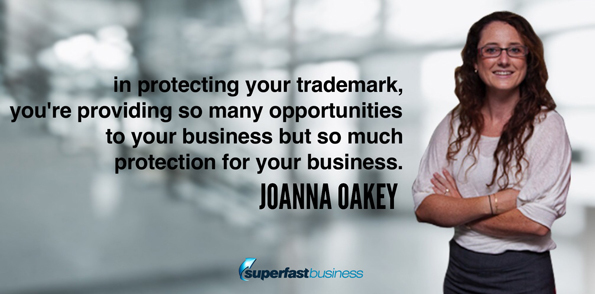 So trademarks, as you say, one of those rights of intellectual property that are capable of protection by way of registration. And in protecting your trademark, you’re providing so many opportunities to your business but so much protection for your business. Once again, I sort of say trademark registration as one of the cheapest types of business insurance you can buy. But many business owners just have no idea about it.
So trademarks, as you say, one of those rights of intellectual property that are capable of protection by way of registration. And in protecting your trademark, you’re providing so many opportunities to your business but so much protection for your business. Once again, I sort of say trademark registration as one of the cheapest types of business insurance you can buy. But many business owners just have no idea about it.
James: Well some people say all of the cost of defending it so high, you’re best not to worry about. I see that one coming up.
Joanna: I guess speaking from the position of sitting behind the desk where I deal with these legal issues essentially every day, I can tell you right now it’s a hell of a lot cheaper to deal with protecting a business’s intellectual property if they’ve protected it. So it’s so much easier for us to stop a competitor using a similar branding in the marketplace if they’ve got a trademark registration than if they don’t.
I’m a big advocate in keeping our clients out of court, so the question for me at the end of the day isn’t what’s going to happen if you drag yourself into court because mostly these things aren’t going to end up in court in any event. Even though I disagree with the proposition that it’s hard to have these things hold up in court, I completely disagree with that. That’s not where the conversation should be anyway. It’s all about, how can I protect my business in the quickest, and the easiest, and the cheapest way without having to think about anything like court.
James: So Joanna, how can I protect my business in the easiest, cheapest way? [laughs]
Joanna: [laughs]
James: By the way, I’ve been on both sides of this. I was partially drowned out for a little while there on a brand that I should have trademarked and didn’t, and I wish I had in hindsight. As a result of that, I trademarked my next brand and someone did enter into the market and we were able to stop that immediately. It was finally good to be on the other side there.
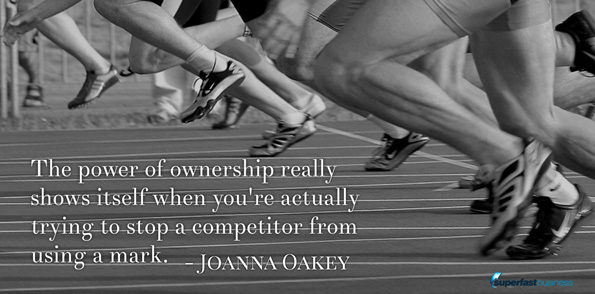 Joanna: Absolutely. That’s it. And the power of that ownership of the trademark registration really shows itself when you’re actually trying to stop a competitor from using a mark. And this also gets down to the way you protect your trademark. As I said before, trademark protection in Australia comes from registration.
Joanna: Absolutely. That’s it. And the power of that ownership of the trademark registration really shows itself when you’re actually trying to stop a competitor from using a mark. And this also gets down to the way you protect your trademark. As I said before, trademark protection in Australia comes from registration.
But one of the issues that I see quite often is the people wondering to trademark registration without having any idea what they’re doing. And when it comes to the time of us having to act for them, to try and stop someone else from using that mark, we can always tell if someone has registered these marks without really understanding what they’re doing or not, because often, that’s when the protection that they think they’ve got has completely fallen down.
So the first thing is to understand what you can protect, the second thing is to protect, and the third thing is to protect it properly rather than do a half-ass effort on it basically.
James: Let’s start then with what you can protect. From my limited understanding, is it something to do with if it’s unique enough?
What you can protect
Joanna: Trademark registrations relate to essentially the branding. So that can be the name, sometimes the tag line, the logo, those sorts of things. Trademarks can actually also be used for sounds, like the sound of the Harley-Davidson roar, or the Dell chime, and smells as well, and colors, the color purple, or type of color purple, which was an interesting case around a few years ago.
But the main things that we look at protecting with trademarks are the logo. So say for example the M for McDonald’s, the golden arches, or the Nike swoosh, or the word itself. There’s a big question as to whether or not you want to protect the word or the logo or both together, and part of that relates to the strategy that you use when you’re applying, which is why I say, when you’re registering a trademark, it comes back to making sure you’re doing it the right way, not in a half-ass way.
James: I remember when I was doing the trademark process, there was a little bit of pushback that the brand was too general. We just had to reword the application and get it through so that we were able to register the trademark for SuperFastBusiness. I used a trademark attorney for this and then we extended that to other countries. I wasn’t going to take it on myself because there’s different classes as well. You need to pick the right ones, right?
Joanna: Absolutely, 45 different classes to choose from. [Laughs]
James: Right. We had a little bit of a dance with the US trademark attorney about what we actually do. I have enough trouble explaining to my mom and dad what my business is, let alone a trademark office. So sometimes, you have to work in their language of what you think you do. Like with the insurance company, you might have to call yourself an IT company. But IT is not the way I think of my business.
Joanna: And you make a really good point there in relation to brand. People often think that just because they’ve done search and can find that they can buy a URL that that brand is fine to use and they’re not going to have any issues using it. But there’s a number of considerations that business owners need to make right at that beginning point when they’re choosing a brand.
Things to consider when choosing a brand
And the first one is are they infringing on someone else’s brand, which sometimes they may not find out for years, and years, and years later. And secondly, are they choosing a brand that’s inherently protectable so that they can register it to stop other business owners from using a similar mark. So these are all the things that people often don’t think about when they’re choosing that name for their organization.
And then often, once they’ve chosen that name, if they haven’t taken steps to protect it, they find it hard to protect the value in that brand that they’ve built up through all of those years in business.
James: So just some basic questions around that. Domain names and trademarks – what is the situation there with regards to those?
Trademark registration
Joanna: So having a domain name doesn’t give you trademark rights. So using a mark, using a name in your business gives you certain trademark rights. But the best trademark rights that you can get are from actually getting a registration for that trademark. Once you’ve got a registration for that trademark, however, you have a lot of power in relation to other people who are using your mark in their domain name. So having a trademark registration can be used in an aggressive way or as an aggressor to stop competitors from misusing that branding in their domain names.
That can be sometimes a little bit tricky, but it’s a hell of a lot easier if you’ve got that trademark registration behind you. And it’s not just URLs. If you find that people are using your mark in their metadata as keywords, in Google AdWords, now we’ve had lots of success with stopping all of that sort of misuse of another business’s mark or one of our client’s marks in all of those sorts of different areas after we’ve been able to shoot off the base of a registered trademark. There’s lots of things that you can do in this area once you have your intellectual property protected.
James: What if someone’s been using the name before you registered the trademark?
Joanna: You could be in a whole world of pain. There’s two different scenarios here. One where someone else has been using the name longer than you, full stop. And then second area is where you’ve been using the name first but someone else has gotten a trademark registration first. You’re likely to be in a whole world of pain one day in both of those instances.
But the instance where someone else has used the name first is an extremely dangerous place to live. So that’s why it’s really important that you’re doing your searching right at the beginning. If you’re in a situation where you suddenly find out that someone else was around before you, the usual strategy that we adopt in cases where someone doesn’t want to rebrand immediately and they’re willing to take a bit of a risk is we’ll try and get under the radar, and get a trademark application through as quickly as possible before that other trader. It won’t stop the risk for the future, but it greatly reduces the risk for a number of reasons.
James: Can you tell the other person to stop using it once you have the trademark, if they’ve already been using it?
Joanna: No. If another trader has used a mark before you, then you don’t want to go after them. It depends. Sorry, I should say mostly, that’s the end but there are ways.
James: Because in my case, it was weird. I’ve been using it for 10 years and then someone in another country started using it, and then I got the trademark. But I couldn’t tell them to stop using it apparently.
Joanna: Yeah, yeah, that’s right, that’s right. I mean there’s all sorts of issues in this online world in relation to where your actual use is, so your trademark rights in different countries as well. So it can be really complex. But the first thing to understand is that you need to make sure you’re not infringing other people’s rights. And the second thing is about protection. But the third is to really think about what markets or what countries you are serious about dominating in, from your own business perspective, what countries you want to have your predominant areas of business in. And you need to be thinking about trademarks in each of those areas.
James: Right. So if you plan to be in certain markets then you should consider them. I was told by one of the trademark attorneys it’s good to get it set up in one country first and then roll it across. Is that right?
Joanna: Yeah. Absolutely. Australia is a party to a convention that essentially means that if you register here, then you have what’s called a priority period to register in various other countries. So one of the really good strategies that many of our clients who have international reach in business apply is registering here in Australia and getting a really strong registration here. And then within six months of that registration then taking registrations in each of the relevant countries that they’re interested in.
James: Now if someone’s listening to this in the UK or the USA, which is highly likely, would it be a similar process, go and see a trademark attorney?
Joanna: Yup. Absolutely.
James: Is it something you should do yourself or get someone to help you with?
Should you get help?
Joanna: Look, I strongly recommend you get help in this area because as I say, with trademark registrations, the only time when you really understand whether or not you’ve done it properly is when you’re trying to use the marks or use the protection you’ve created, which can sometimes be years after your actual registration. To find out then that you’ve done it wrong. And there’s lots of intricacies in relation to choosing, being clear about who the owner of the mark is, choosing the right classes of goods and services out of the 45 options, drafting your trademark in a way that it protects your goods and services in a broad enough way but doesn’t leave you too exposed and in a way that avoids other potential citations or other marks.
It can be a lot more tricky than people really realize from the outset. So I say don’t leave it until the time when you want to use your mark to work out if it’s done right. Do it right from the beginning.
James: Right. For a lot of my students, we set a trigger point. When their business is substantial enough that they wouldn’t want to lose it, that’s when they absolutely have to have the correct structure, and they have to protect their intellectual property. I’ve had some really curly ones where they’ve built out an entire successful business but they don’t own the trademark. I’ve actually helped people get the trademark; either licensed it, buy the trademark from the owner, buy the business from the owner that has the trademark, like all sorts of things to fix it. In some cases, we’ve been quite successful with that. And they were completely unaware. Sometimes, I imagine people will just sit there on the sideline and wait until the company gets bigger, and bigger, and bigger, until they enforce it.
Joanna: Absolutely. I’ve definitely seen that happen. People think they can make a bit of money out of holding trademarks. You know, it’s true, they can. It’s a really powerful thing to hold a trademark if someone else wants it.
James: By the way, I really liked that idea that you don’t really know if you’ve done it right until you need to claim it. That’s kind of like my travel insurance was worth nothing when I went to claim on it from a theft because of the sneaky, little terms and conditions they had in there. They weaseled out of it entirely, and I got nothing. In hindsight, I was never covered the whole time I’ve been travelling.
Joanna: Yeah, wow. And then you’re never excited about saving $20, right?
James: Well you know, I would have paid more if I’d realized, but they were very sneaky. A really basic one, if you rent a vehicle and it’s a wagon, they’re not going to cover anything unless it’s locked in the glove box. Try doing that with your checked out luggage. It doesn’t fit to start with. So I was just like, “Really disappointing.”
Let’s talk about staffing, both in your office there or in the same country under the same law. And then perhaps an overseas team, which is a very common scenario for people in our space. Certainly in my business but lots of other people that I am familiar with have an overseas team. They might think that there’s no issue there because they’re outside of the country. So let’s split this into two.
We’ll go for the obvious one first. If you’ve got someone who works in the same country as you, what sort of staffing legal aspect should we be looking at?
Staffing in your own country
Joanna: There are so many things that you need to be thinking from a staffing perspective. Business owners often forget when they’re in that love phase of just having hired, this new staff member, everything feels like it’s going to go well, they might have a really short letter of engagement in place or some sort of shorting agreement, which they may or may not actually ever get the employee to sign. And the issues that this can create later on down the track is number one, staff leaving and taking intellectual property of the business. So that might be client lists or other IP that they’ve set up while they’re with the business.
I see issues with unfair dismissal claims. So employees raising claims if they’ve been terminated. In Australia, it’s really cheap for an employee to commence an action against an employer for termination. They just pay a small amount of money and wham bam, you as the employer is suddenly in court. So this is one of the really, regular sort of issues that I see come up in areas of growing businesses. So business owners who haven’t really thought about these issues haven’t got the processes in place, and the right agreements in place, and the right documentation in place.
And then suddenly, they end up with this action on their doorstep, and they’re thrown for six. I’ve had clients also that have had staff make claims for backpay over the past 10 years of employment, which in one case, ended up with an $80,000 claim. So this was a really small business, and one day, they’re just running along swimmingly, the next day, they have an argument with their employee who leaves them and then they end up with this letter from a lawyer demanding more than $80,000 in back pay for the last 10 years for a 15-minute mail break that had accumulated every day for the last 10 years. So there’s some crazy stuff out there.
Different regulations
James: So there’s all sorts of elements. In some roles, there’s a union, there are delegates who are sort of looking for leverage with the employers, there’s direct contracts in some environments where I suppose some people might inadvertently rip themselves off and then come to realize that later, with the help of some legal representation, I think in Australia, certainly there’s different regulations depending on the size of the company. Or it used to be when I was in the business.
Joanna: Yeah, yeah, yeah. And that particularly impacts the concept of dismissal or termination, because termination for a small business can be a bit easy to deal within the first 12 months, whereas for a large business, it’s six months, which sort of then corresponds with the probationary period that employers are giving.
One of the complexities in this area is that we have all of these workplace relations law, which is based on legislation. But then you also have a contract that you might have with your employee, which introduces a whole new body of law. So you’ve got lots of different areas that you need to be thinking about, making sure that they all line up together, because quite often, what we say is when clients come to us with issues, the first thing we noticed is there’s a real disparity between what they have to do and then what they say they’re going to do in their contracts, what they have to do from a legislative perspective, and then what they do do. So you’ve got these three things that none of which line up.
James: So what’s your advice to an employer? Again, a typical listener is probably employing between one and say 15 staff members if they’ve got a little office locally.
Joanna: Yup. Even with one staff member, that one to 15 number…
James: One is enough to have some fun and games, isn’t it? You’re dealing with humans.
Joanna: Absolutely, absolutely.
James: The funny thing happens when people are single-source dependent on their income, the stakes are very high if they have a mortgage or a car payment due and you’re having friction. That can be a flammable situation.
Joanna: And sometimes, friction can be caused by third-party elements, say for example, partners of your employee.
James: Definitely. That’s so interesting that you mentioned that. A lot of the time when I’m coaching someone, I’m really coaching their partner. And the person I’m coaching is the conduit between the real decision maker or the person who’s driving it is often one layer behind the scenes.
Joanna: And people think, I’ve got this relationship with this employee. I know how they work. But five years down the track, you don’t know what the pressures in their lives are going to be and what the other influences might be on this person. So it’s just about setting up the right systems from the beginning. I think that’s what it’s all about here. It’s about understanding where the risk is, understanding what your obligations are and just setting things up right from the beginning.
James: Typical sort of documents that we’d be looking at, I know in the part two, we’re going to cover some key agreements and staffing documents are in there. So we don’t have to go too deep into that. But what would you say to someone listening to this should check that they have if they’ve already got staff employed. What would be a fundamental thing to make sure that is in place?
Fundamental things to have
Joanna: Yes. So you need to make sure that you’ve got an employment contract with your staff and that the employment contract is signed and that you know where it is. I can’t tell you how few businesses I’ve ever reviewed that have ever been able to produce to me, signed copies of employment contracts with all of their staff. But you know, if it’s a system, it’s super easy. But they just don’t realize why it’s important until something goes wrong.
James: Is a scanned or electronic version in a Dropbox countable?
Joanna: Yeah, that’s fine.
James: Right. OK. That’s terrific.
Joanna: That’s fine.
James: I think also, if you’re going to take out business insurance, then they’re probably going to want to ask you questions about if you have agreements with your staff members and also contractors, right?
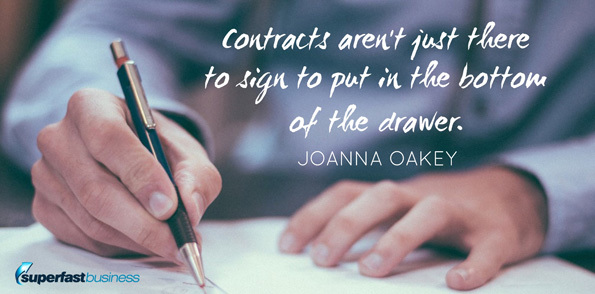 Joanna: Yeah, absolutely. And it’s about having the right terms in those agreements as well. So it’s not just about having agreements, it’s about having the right terms. And quite often, when people start businesses, they’ll borrow a copy of an agreement that may have been their employment agreement from their previous employer, not realizing that workplace relations laws have probably changed since they signed their contract. And not thinking about how this contract is applicable to their situation. I’m a really big believer in contracts aren’t just there to sign to put in the bottom of the drawer and to be a dead document that is only pulled out when there’s an issue.
Joanna: Yeah, absolutely. And it’s about having the right terms in those agreements as well. So it’s not just about having agreements, it’s about having the right terms. And quite often, when people start businesses, they’ll borrow a copy of an agreement that may have been their employment agreement from their previous employer, not realizing that workplace relations laws have probably changed since they signed their contract. And not thinking about how this contract is applicable to their situation. I’m a really big believer in contracts aren’t just there to sign to put in the bottom of the drawer and to be a dead document that is only pulled out when there’s an issue.
It’s all about having the right agreements in place so that they are leaving document that helped established the relationship. They sort of act as a checklist that if you’d remember to talk about each of those things that are important, and each of the things that you should be doing and should be getting agreement from your employees. So that might be expectations in relation to what they will and won’t do after they leave you. And that’s a really big one because that’s when often the relationship has parted and then suddenly an ex-staff member behaves in a way that the employer would never have anticipated.
So it’s about making sure you’re clear about what happens when your relationship parts ways but also what your expectations of them are while they’re still there.
James: That seems a pretty common one with local staff especially anything relating to sales, it’s quite common that customers of the business would be approached by an ex-staff member and recruited or solicited for a new business.
Joanna: Yeah, yeah. And look, that’s one of those things that you really need strong contractual protection if you want to make sure that doesn’t happen. But one of the issues is sometimes, business owners overshoot and they draft or they write in clauses themselves that are really, highly onerous. And in Australia, if you have a clause that overshoots in that sort of area or is overly onerous, then you might find that it just won’t stand up at all. So the risk you’re running is you’ve made it too stringent, and now, you can’t get any protection at all because the whole thing is void.
James: For being a bit too greedy.
Joanna: Exactly.
James: I’ve noticed with contracts, that’s quite a usual thing is that one party wants the other party to take all the risk and they don’t want to take any and then you have pushed back and you’re trying to push it the other way and then it’s sort of finding that middle ground. I suppose a lot of times, a staff member is not going to be in such a strong position to get access to legal help or to interpret the documents when they’re kind of lucky to have a job in their mind and maybe don’t have too many choices.
Sometimes, I wouldn’t call it duress but they might be in a slightly ignorant situation where they might just sort of go along with it. But letting someone sign a document that’s not going to help you later doesn’t help anybody.
Joanna: Yeah absolutely. That’s right. And it’s back to the same old trademark issue. Sometimes, you don’t know whether or not these documents will stand up until you’re actually trying to use them. And if you then find you’ve gone too hard, you’ve been too greedy, you’ve gone too light, you haven’t protected yourself enough. It’s at that point that you suddenly realize what you should have done in the beginning but it’s too late.
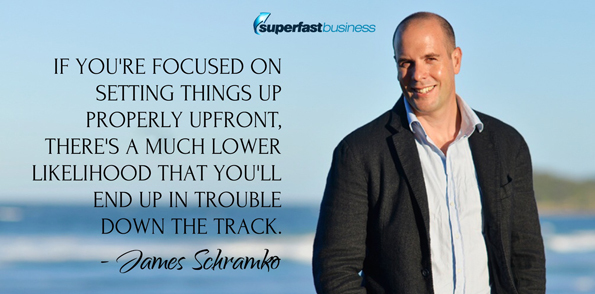 James: I guess to a large extent, the clearer you are and the more focused you are on having good documents and setting things up properly upfront, there’s a much lower likelihood that you’ll end up in trouble down the track because you went to that effort.
James: I guess to a large extent, the clearer you are and the more focused you are on having good documents and setting things up properly upfront, there’s a much lower likelihood that you’ll end up in trouble down the track because you went to that effort.
Joanna: Absolutely true. Absolutely true. The clearer you are, the less ambiguity that exists, the less likely there’s going to be dispute, because you only have a dispute because both people think they’re right. So if you’ve got a really clear position in a clear and understandable way, so here we’re talking about making sure we have contracts that are easy to understand, that aren’t written in legalese, which often happens if people have poached documents or if they’re trying to write at themselves, because often, when people try to write things themselves, they think they need to use all of these legalese but it ends up making no sense.
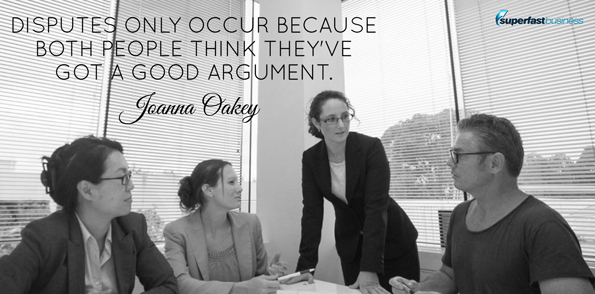 So, at the end of the day, if you’ve got a really simple, clear document, and you’ve dealt with all of the issues correctly, then you’re almost guaranteed not to end up in dispute, because as I said, disputes only occur because both people think they’ve got a good argument.
So, at the end of the day, if you’ve got a really simple, clear document, and you’ve dealt with all of the issues correctly, then you’re almost guaranteed not to end up in dispute, because as I said, disputes only occur because both people think they’ve got a good argument.
James: Right. So if you have really clear documents, it’s a good chance that the other person’s legal adviser will say, “Hey, you don’t have any grounds for your claim. You should just drop it. It’s not worth pursuing.”
Joanna: Absolutely right. And this is a universal of every single contract any business owner will ever deal with, whether they’re a small business with just them or if they’re multi-national businesses where you deal with multi-national businesses as well. But it’s the same advice across the link. It’s about making your agreements easy to understand, simple, but comprehensive.
Handling overseas team members
James: Perfect. So let’s just round out this comprehensive episode. We’re talking about if we have team members overseas, obviously, they’re not going to be subject to our local employment laws. In some cases, there may be very little recourse between us and the team member, but they can still do plenty of damage for the business, can’t they?
Joanna: Oh totally, they can. If you’re creating intellectual property for example, for clients as part of your services; let’s say you’re a graphic designer, you’re a web developer, you’re a copywriter, anything that involves you creating some sort of intellectual property, quite often, what will happen particularly if you have larger clients or if you’re interested in ever getting corporate clients, they’ll usually have an agreement that you need to sign where you provide certain warranties or guarantees in relation to the fact that you’re passing over the intellectual property to them. That’s just how the game goes.
If you haven’t got that line or that chain of intellectual property protection, so you don’t have an agreement with your staff that relates to that transfer of intellectual property, you’re in the position where you’re opening yourself up to a lot of risk.
But on the flip side, I highly recommend a very simple agreement with overseas contractors. But there’s still a number of things that it’s important that you cover off. In Australia, there’s a concept of moral rights, which I won’t go into, but it’s part of that whole copyright and intellectual property law side of things. So you need all of these clauses that deal with these areas if you’re dealing with intellectual property. If you’re dealing with any information that might be considered confidential, then we need some appropriate confidentiality clauses.
Just having the sensible discussion in a document about the obligations that you have of your staff. You know, how long do you expect them to work, when do you expect them to be there; if these things are in the document and someone is signing on the bottom of that document, usually, they will understand that there is some seriousness to the obligations that you’re giving them.
And quite often, when we deal with offshore stuff, we don’t get into a lot of detail and into the detail that we should about what our expectations are of them. So how can we expect them to understand what our expectations are if we haven’t been clear about it? A document like this is the perfect point for you to be able to be clear about what your business requirement are of them and for your offshore staff to have the opportunity to understand what your requirements are and sign on the dotted line to indicate that they understand that.
And usually, people want to do the right thing, right? Well this is the perspective that I have in life, and that I usually see play out. So if people have signed a document, they’re far more likely to do what is set out in that document than if they haven’t.
James: Yeah, that’s a commitment and consistency influencer from Robert Cialdini.
Joanna: There you go.
James: So it makes sense. And we shouldn’t assume that they have the same understanding as us. For example, in some countries where we’re hiring team members, they have a different cultural philosophy regarding things like ownership of content. It’ll be far more common for people in some countries to just swipe an image of Google or grab some music from somewhere and put it into a video without realizing that they might be infringing copyright in Australia or the US. You can’t present that work to a client. So it’s really good to provide education to your team members to protect yourself from being put in a position of liability.
I remember, one of my customers had a team member make something like 32 videos with a popular top 40 track, music track in it, and as soon as they got loaded to YouTube, they got slapped with a cease and desist. So they just don’t even know that that’s a thing. That wasn’t our customer just to be very clear because we were on top of that. But it’s an example of what can happen if you don’t cover off on these things.
Joanna: Absolutely.
James: I know when you do insurance policy, they want to see the agreements you have with your team members. If you are dealing with third-party customers, then it’s just good protection for you to have in case there’s some issue down the track. And it’s good for your employees and contractors to know exactly what’s expected of them, how much they’ll be rewarded if they do their role, and what would be grounds for you not to be working together anymore.
Joanna: Absolutely. And I guess the last point I’d put in all of this, which we’ll cover off in episode three, but if you’re ever considering selling your business, buyers hate risk. So if you can show that from the beginning, you have protected yourself by having these right contracts in place, then that can really, massively impact the potential sale price in the future.
James: You are spot on. I’m really looking forward to episode three because having sold a few businesses this year, I can assure you that the employee agreements and the asset register we created of all the digital assets of the business really formed the solid basis of what the sale was all about.
Quick recap
Just a quick recap; in this episode, we talked about getting the right structure, we talked about protecting your intellectual property, and we talked about staffing both locally and overseas. In the next episode, we’re going to go into some key agreements that you want to have in place. We’ll talk about disputes and how you can have systems for your cashflow. The third episode, we’re going to get into that selling your business.
So I’ve been speaking with Joanna Oakey from AspectLegal.com.au. Thank you for sharing this legal stuff.
Joanna: Thanks James.
James: Normally, I’d expect a very large bill for this kind of information. But I will say that the investments I’ve made in legal advice over the last few years have navigated me safely through business. It’s the right thing to do. Go and see a professional in your local area and get yourself sorted out. If you’ve been flying by the seat of your pants, take this episode as a wake up before it gets sticky. Joanna, I’m looking forward to getting back on part two with you.
Joanna: Great. Me too. Thanks James.
Enjoyed this episode? Be sure to comment on iTunes

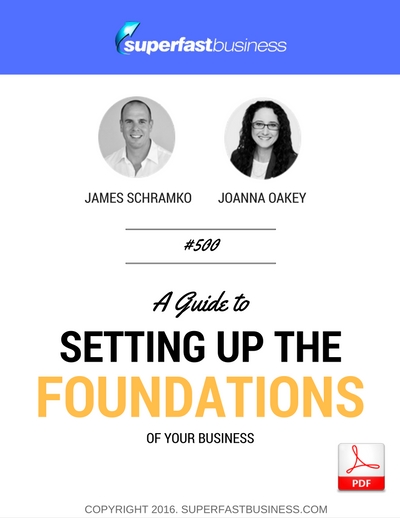









Another outstanding and useful podcast James! Well done to both of you and thanks for all the tips :-)
I have a question regarding domain names and trademarks. What is the situation if someone else owns a domain name and the domain name is parked and up for sale before you start to trademark a name and when you’re still deciding on a name for a product or business and you’re still looking to make a decision?
Many thanks,
Angelo
Another outstanding and useful podcast James! Well done to both of you and thanks for all the tips :-)
I have a question regarding domain names and trademarks. What is the situation if someone else owns a domain name and the domain name is parked and up for sale before you start to trademark a name and when you’re still deciding on a name for a product or business and you’re still looking to make a decision?
Many thanks,
Angelo
I usually buy the domain name before I spend money trademarking.
Thanks James. However what is the deal on a legal perspective if you trademark first. Are you then entilted to that domain name?
It might depend if they have been using the name already (Prior use).
As far as I can see, there’s no prior use of the name.
Hi Angelo, the first consideration is whether or not your use of that mark might end up infringing someone else’s rights (ie someone else registering a domain might indicate that they are starting to use that mark somewhere else – so you should do some general searching to check this, including a trademark search if its relevant – I would definitely suggest a trademark search if it is for a new business name). If this domain is up for sale without anything else attached to it, it sounds like the mark isnt being used by this holder (but it might be being used by someone else, so general checking is still useful). In relation to your 2nd question – you can potentially use a trademark registration later down the track to stop someone else from using that trademark in their domain name, however the success of this approach will depend on a lot of variables (eg whether they are actually using the mark, whether the use is in the same jurisdiction as your trademark protection, whether the use is for the same goods/services as your protection, etc). It is often difficult to stop people from holding a domain name that they arent using unless you start using the dispute resolution procedures that relate to the type of domain (there are different rules depending on whether its a .com or a .com.au etc) – and those processes can also often be difficult.
thank you so Much !
Thanks very much Joanna, that’s very helpful!
My pleasure!